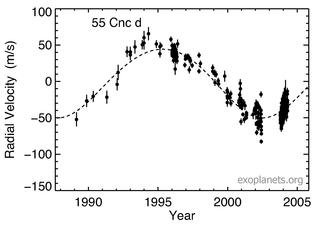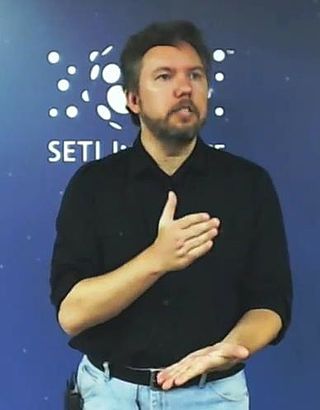Related Research Articles

An exoplanet or extrasolar planet is a planet outside the Solar System. The first possible evidence of an exoplanet was noted in 1917 but was not then recognized as such. The first confirmed detection of an exoplanet was in 1992 around a pulsar, and the first detection around a main-sequence star was in 1995. A different planet, first detected in 1988, was confirmed in 2003. As of 19 December 2024, there are 5,811 confirmed exoplanets in 4,340 planetary systems, with 973 systems having more than one planet. In collaboration with ground-based and other space-based observatories the James Webb Space Telescope (JWST) is expected to give more insight into exoplanet traits, such as their composition, environmental conditions, and potential for life.

A planet is a large, rounded astronomical body that is generally required to be in orbit around a star, stellar remnant, or brown dwarf, and is not one itself. The Solar System has eight planets by the most restrictive definition of the term: the terrestrial planets Mercury, Venus, Earth, and Mars, and the giant planets Jupiter, Saturn, Uranus, and Neptune. The best available theory of planet formation is the nebular hypothesis, which posits that an interstellar cloud collapses out of a nebula to create a young protostar orbited by a protoplanetary disk. Planets grow in this disk by the gradual accumulation of material driven by gravity, a process called accretion.
GJ 1061 is a red dwarf star located 12 light-years from Earth in the southern constellation of Horologium. Even though it is a relatively nearby star, it has an apparent visual magnitude of about 13, so it can only be seen with at least a moderately-sized telescope.

Gliese 876 is a red dwarf star 15.2 light-years away from Earth in the constellation of Aquarius. It is one of the closest known stars to the Sun confirmed to possess a planetary system with more than two planets, after GJ 1061, YZ Ceti, Tau Ceti, and Wolf 1061; as of 2018, four extrasolar planets have been found to orbit the star. The planetary system is also notable for the orbital properties of its planets. It is the only known system of orbital companions to exhibit a near-triple conjunction in the rare phenomenon of Laplace resonance. It is also the first extrasolar system around a normal star with measured coplanarity. While planets b and c are located in the system's habitable zone, they are giant planets believed to be analogous to Jupiter.

Wolf 1061 is an M-class red dwarf star located about 14.1 light-years away in the constellation Ophiuchus. It is the 36th-closest-known star system to the Sun and has a relatively high proper motion of 1.2 seconds of arc per year. Wolf 1061 does not have any unusual spectroscopic features.

In astronomy, 55 Cancri d is an extrasolar planet in a long-period orbit around the Sun-like star 55 Cancri A. Formally named Lipperhey, the planet is located at a similar distance from its star as Jupiter is from the Sun, it is the fifth and outermost known planet in its planetary system. 55 Cancri d was discovered on June 13, 2002.

TrES-2b is an extrasolar planet orbiting the star GSC 03549-02811 located 750 light years away from the Solar System. The planet was identified in 2011 as the darkest known exoplanet, reflecting less than 1% of any light that hits it. Reflecting less light than charcoal, on the surface the planet is said to be pitch black. The planet's mass and radius indicate that it is a gas giant with a bulk composition similar to that of Jupiter. Unlike Jupiter, but similar to many planets detected around other stars, TrES-2b is located very close to its star and belongs to the class of planets known as hot Jupiters. This system was within the field of view of the Kepler spacecraft.

Any planet is an extremely faint light source compared to its parent star. For example, a star like the Sun is about a billion times as bright as the reflected light from any of the planets orbiting it. In addition to the intrinsic difficulty of detecting such a faint light source, the light from the parent star causes a glare that washes it out. For those reasons, very few of the exoplanets reported as of January 2024 have been observed directly, with even fewer being resolved from their host star.

A Super-Earth or super-terran or super-tellurian is a type of exoplanet with a mass higher than Earth, but substantially below those of the Solar System's ice giants, Uranus and Neptune, which are 14.5 and 17.1 times Earth's, respectively. The term "super-Earth" refers only to the mass of the planet, and so does not imply anything about the surface conditions or habitability. The alternative term "gas dwarfs" may be more accurate for those at the higher end of the mass scale, although "mini-Neptunes" is a more common term.

An exoplanet is a planet located outside the Solar System. The first evidence of an exoplanet was noted as early as 1917, but was not recognized as such until 2016; no planet discovery has yet come from that evidence. What turned out to be the first detection of an exoplanet was published among a list of possible candidates in 1988, though not confirmed until 2003. The first confirmed detection came in 1992, with the discovery of terrestrial-mass planets orbiting the pulsar PSR B1257+12. The first confirmation of an exoplanet orbiting a main-sequence star was made in 1995, when a giant planet was found in a four-day orbit around the nearby star 51 Pegasi. Some exoplanets have been imaged directly by telescopes, but the vast majority have been detected through indirect methods, such as the transit method and the radial-velocity method. As of 24 July 2024, there are 7,026 confirmed exoplanets in 4,949 planetary systems, with 1007 systems having more than one planet. This is a list of the most notable discoveries.

Kepler-186 is a main-sequence M1-type dwarf star, located 177.5 parsecs away in the constellation of Cygnus. The star is slightly cooler than the sun, with roughly half its metallicity. It is known to have five planets, including the first Earth-sized world discovered in the habitable zone: Kepler-186f. The star hosts four other planets discovered so far, though they all orbit interior to the habitable zone.

Kepler-438b is a confirmed near-Earth-sized exoplanet. It is likely rocky. It orbits on the inner edge of the habitable zone of a red dwarf, Kepler-438, about 460.2 light-years from Earth in the constellation Lyra. It receives 1.4 times our solar flux. The planet was discovered by NASA's Kepler spacecraft using the transit method, in which the dimming effect that a planet causes as it crosses in front of its star is measured. NASA announced the confirmation of the exoplanet on 6 January 2015.

Wolf 1061 c is an exoplanet orbiting within the habitable zone of the red dwarf star Wolf 1061 in the constellation Ophiuchus, about 14.1 light-years from Earth. At the time of discovery, it was the closest known potentially habitable exoplanet to Earth, though several closer ones have since been found. It is the second planet in order from its host star in a triple planetary system, and has an orbital period of 17.9 days. Wolf 1061 c is classified as a super-Earth exoplanet as its mass is between that of Earth and the ice giants.
Wolf 1061d is an exoplanet orbiting the red dwarf star Wolf 1061 in the Ophiuchus constellation, about 13.8 light years from Earth. It is the third and furthest planet in order from its host star in a triple planetary system, and has an orbital period of about 217 days.

Stephen Kane is a full professor of astronomy and planetary astrophysics at the University of California, Riverside who specializes in exoplanetary science. His work covers a broad range of exoplanet detection methods, including the microlensing, transit, radial velocity, and imaging techniques. He is a leading expert on the topic of planetary habitability and the habitable zone of planetary systems. He has published hundreds of peer reviewed scientific papers and has discovered/co-discovered several hundred planets orbiting other stars. He is a prolific advocate of interdisciplinarity science and studying Venus as an exoplanet analog.
Tau Ceti f is a potential super-Earth or mini-Neptune orbiting Tau Ceti that was discovered in 2012 by statistical analyses of the star's variations in radial velocity, based on data obtained using HIRES, AAPS, and HARPS. It is of interest because its orbit places it in Tau Ceti's extended habitable zone, but a 2015 study implies that there may not be a detectable biosignature because it has only been in the temperate zone for less than one billion years. In 2017, it was again recovered from radial-velocity data, along with Tau Ceti e. Despite this, it remains an unconfirmed candidate.

Wolf 1069 is a red dwarf star located 31.2 light-years away from the Solar System in the constellation of Cygnus. The star has 17% the mass and 18% the radius of the Sun, a temperature of 3,158 K, and a slow rotation period of 150–170 days. It hosts one known exoplanet called Wolf 1069 b which could possibly sustain life.
References
- ↑ "Wolf 1061 b". Extrasolar Planets Encyclopaedia . 1995. Retrieved 2015-12-20.
- 1 2 "Three planets orbiting Wolf 1061" (PDF). Retrieved 2015-12-20.
- ↑ Kane, Stephen R; Kaspar von Braun; Henry, Gregory W; Waters, Miranda A; Boyajian, Tabetha S; Mann, Andrew W (2016). "Characterization of the Wolf 1061 Planetary System". The Astrophysical Journal. 835 (2): 200. arXiv: 1612.09324 . Bibcode:2017ApJ...835..200K. doi: 10.3847/1538-4357/835/2/200 . S2CID 30738573.



